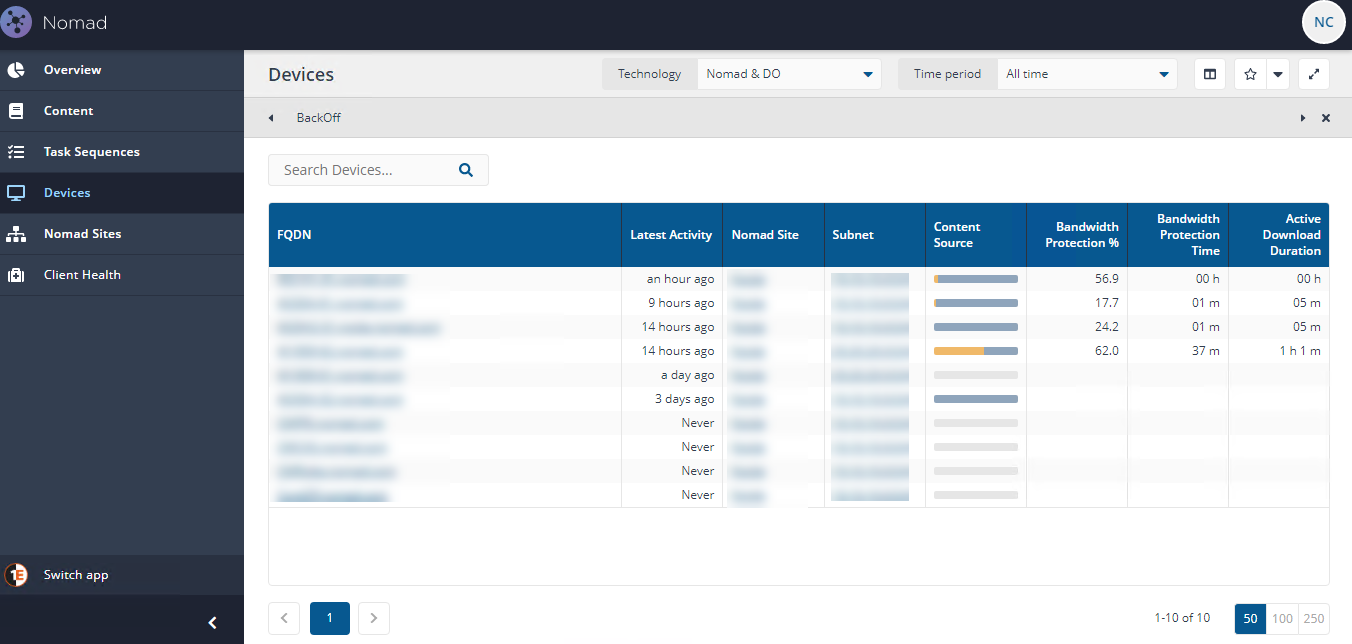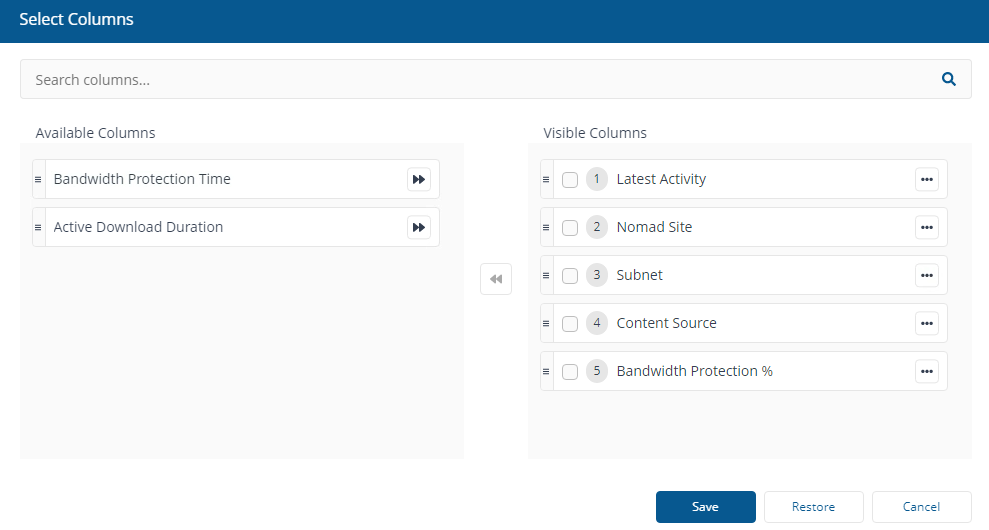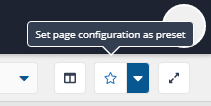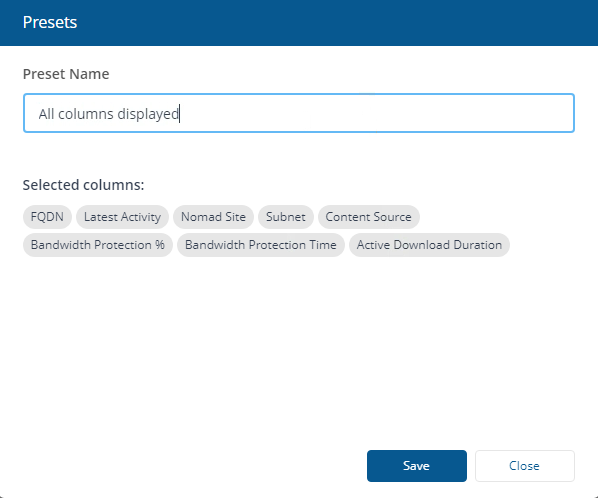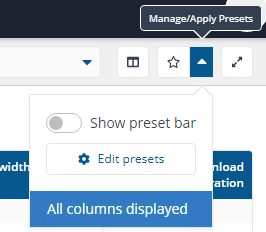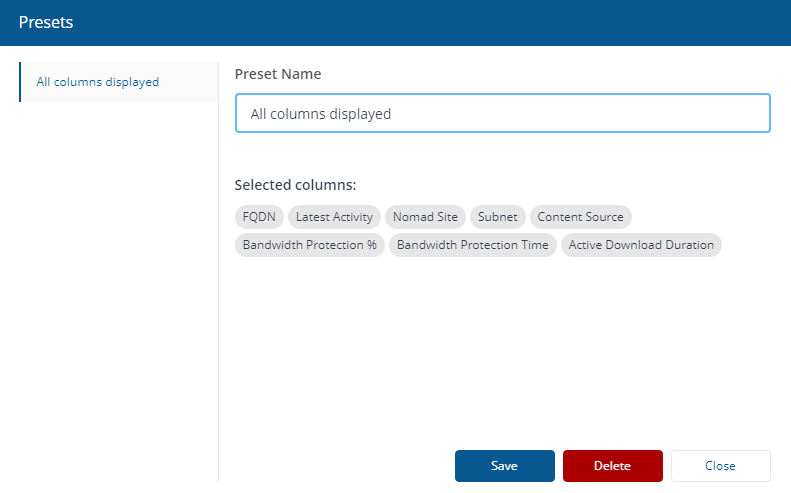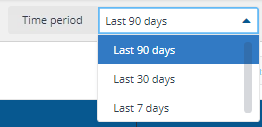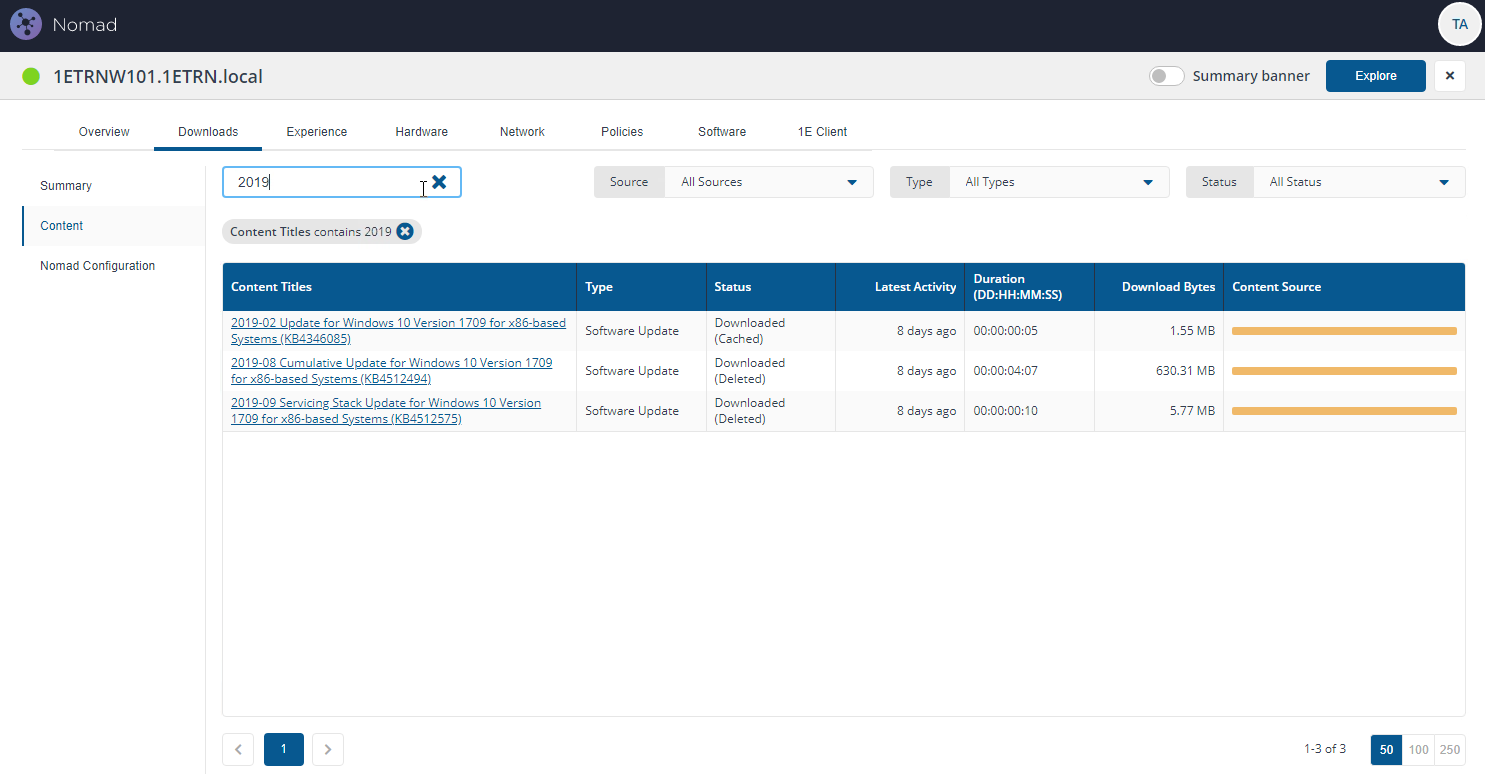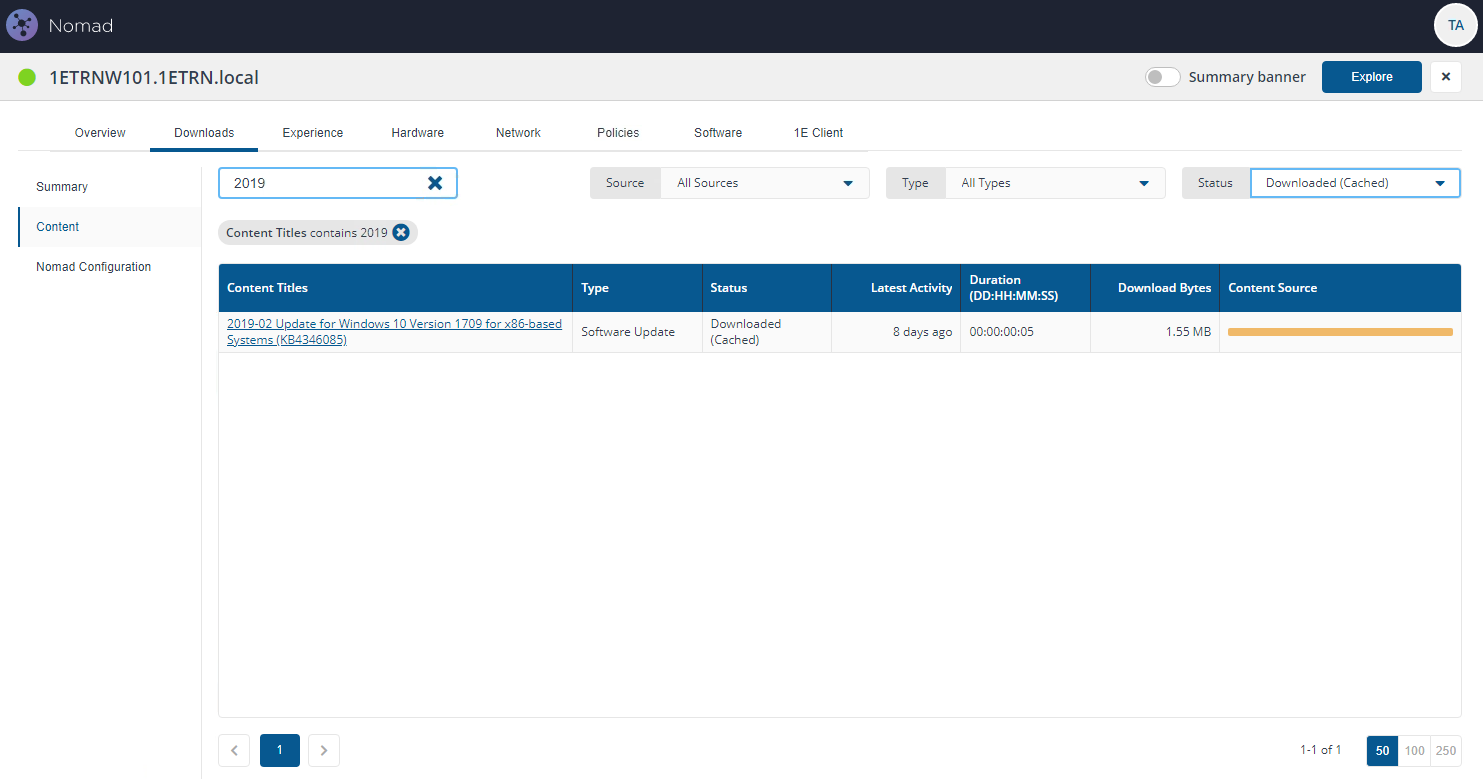Devices page
The Devices page lists all Devices that have sent Nomad device registration events and have sent download events within the selected Time period.
The Device view Downloads tab
The Device view is a common view used throughout Tachyon to present details of a device from multiple Tachyon Platform applications.
The default view in the Nomad devices view is Downloads. The remaining tabs display information corresponding to an app, feature or data set implemented in Tachyon, other tabs are visible if an app has been installed and licensed, and the user has permissions to use the app, refer to Additional Device View Tabs for detail. Clicking on one of the links in the FQDN column of the Devices page displays the Device view for the selected device. The aim of the Device view is to provide a combined overview of all the information known about a device, along with the ability to retrieve information about the device in real-time. When displaying the Device view from a Nomad page, the view defaults to the Downloads tab. The Downloads tab contains information derived from and useful for using Nomad.
In addition, the Summary banner displays a quick summary of the information provided in the various tabs displayed in the Device View. It can be viewed by toggling the Summary banner switch to on, refer to Summary banner for details.
Note
The Time period filter does not apply to detail pages. As a result, if you have set theTime periodfilter on theDevices page to, for example,Last 7 days, you may see different results on the detail page for a device.
Note
The details shown on the Downloads and other tabs rely on access to the associated app, but also Instruction Sets used by the Tachyon Platform. >To view details in the Downloads tab for the Nomad app you'll need to load the 1E Nomad product pack. For more details, refer to Installing the Nomad app - 1E Nomad product pack.
Downloads tab
TheDownloadstab has three items:
The Downloads tab presents download activity and status for the device. Whenever you click on an FQDN on any of the Nomad dashboard pages, the Device details page will be displayed with the Downloads tab selected.
Summary
Summary has four panels:
Status bar
Bandwidth Usage Per Day by Content Source (UTC)
P2P Efficiency by Content Source
Content Titles Count by Content Type.
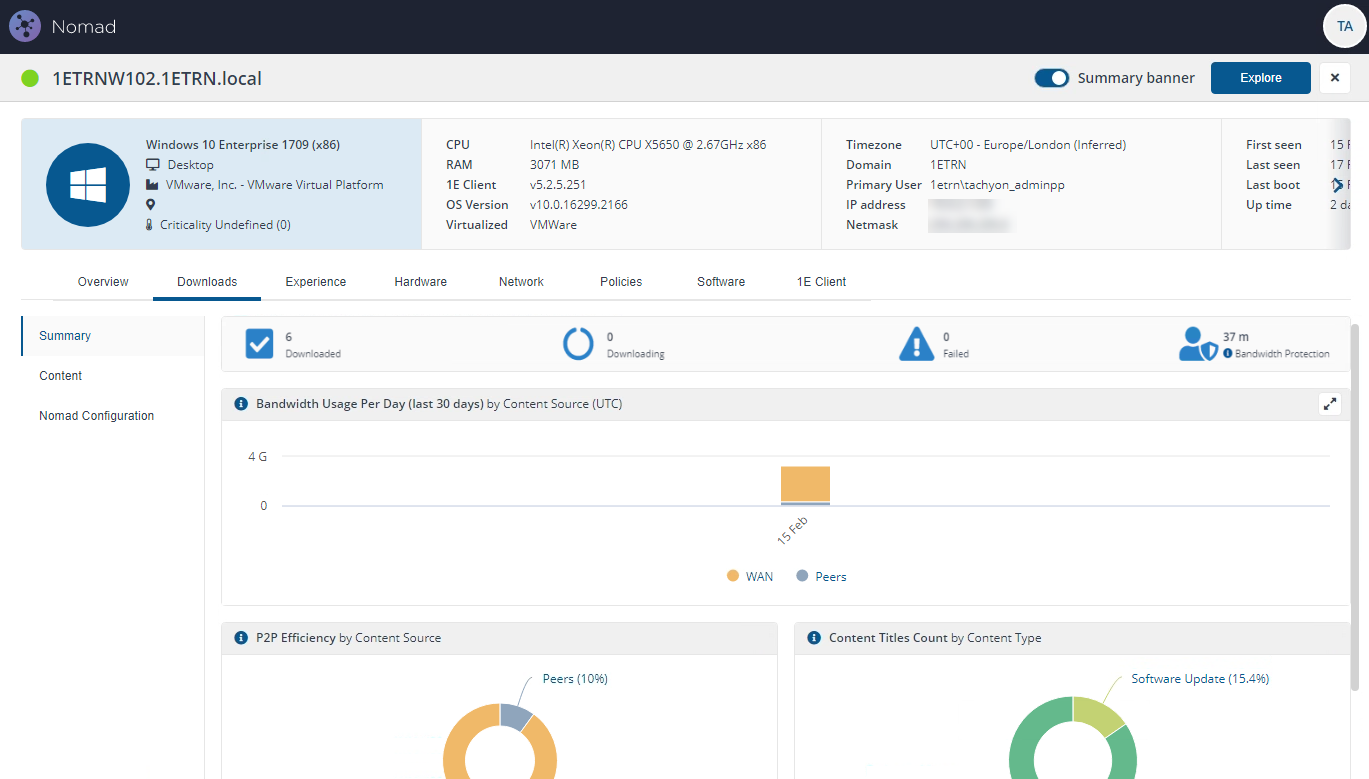
Status bar
The status bar along the top shows high-level download statistics for this device:
Column | Description |
|---|---|
Downloaded | Number of completed downloads on this device. |
Downloading | Number of downloads that are actively in progress on this device. |
Failed | Number of downloads on devices that are currently in the site, whose latest status is failed. |
Bandwidth Protection | Bandwidth Protection allows Nomad to adjust the speed of ongoing downloads to save bandwidth for other business use. Bandwidth Protection ensures Nomad doesn't consume excess bandwidth and hinder other business activity. |
Clicking on any of these icons will navigate to theContentview of theDevice detailtab, filtered according to the clicked icon.

Bandwidth Usage Per Day by Content Source (UTC)
The Bandwidth Usage Per Day by Content Source (UTC) tile represents daily download activity on this device for the last 30 days. A column is displayed for each day when there was download activity. Each column indicates the volume of content that was downloaded over the WAN (in orange) or from peers (in grey).
Hovering over a segment of the column displays the volume of content downloaded on that day, demonstrating the value that Nomad and Delivery Optimization are providing through reduced WAN traffic. If the majority of content is being downloaded over the WAN, it could indicate that peers are simply not available (e.g. this device is being used from home) or it could be an indication that Nomad or Delivery Optimization are not correctly configured to optimize content from peers.

P2P Efficiency by Content Source
The P2P Efficiency by Content Source tile represents the overall peer-to-peer efficiency on this device. The data is grouped by source (Peers and WAN) and displayed as a donut chart showing the volume of content downloaded from peers (in grey) and from the source over the WAN (in orange).
The chart gives an indication of the overall value of Nomad and Delivery Optimization on this device. Ideally, more content will be downloaded from peers than from the source over the WAN, thereby saving network bandwidth. Where this is not the case, it could be due to remote working (where there are no peers available), or it could be due to configuration settings on the client that are not optimized for peer-to-peer caching and availability.
Clicking on a segment in this chart will navigate to the Content view for this device, filtered to show content that was downloaded from the selected source (Peer or WAN).
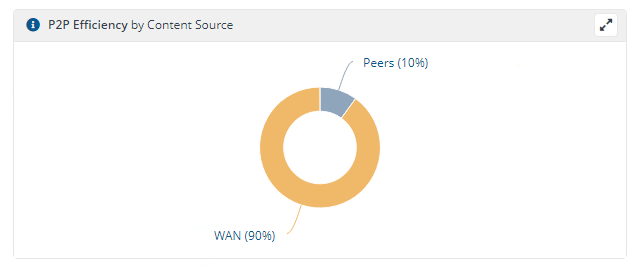
Content Titles Count by Content Type
The Content Titles Count by Content Type chart gives an indication of the number of Endpoint Manager applications and Software Update this device has downloaded.
Clicking on a segment in this chart will navigate to the Content view for this device, filtered by the selected Content Type.

Content
The Content panel shows the status of content downloaded on the device:
Column | Description |
|---|---|
Content Titles | Content title, for:
|
Type | Currently, either Endpoint Manager or Software Update. |
Status | Current status of the content on this device. This can include the following statuses.
|
Latest Activity | Date and time of the latest event for the content title on this device. |
Duration | The time taken to download the content. |
Download Bytes | Amount of bytes of the content actually downloaded by the device. In some cases, especially with Software Updates, only deltas or byte ranges will be downloaded rather than the entire source content. |
Content Source | A bar indicating the proportion of the content that was downloaded over the WAN or from peers. |
Note
The Time period filter does not apply to detail pages.
As a result, if you have set the Time period filter on the Devices page to, for example, Last 7 days, you may see different results on the detail page for a device.
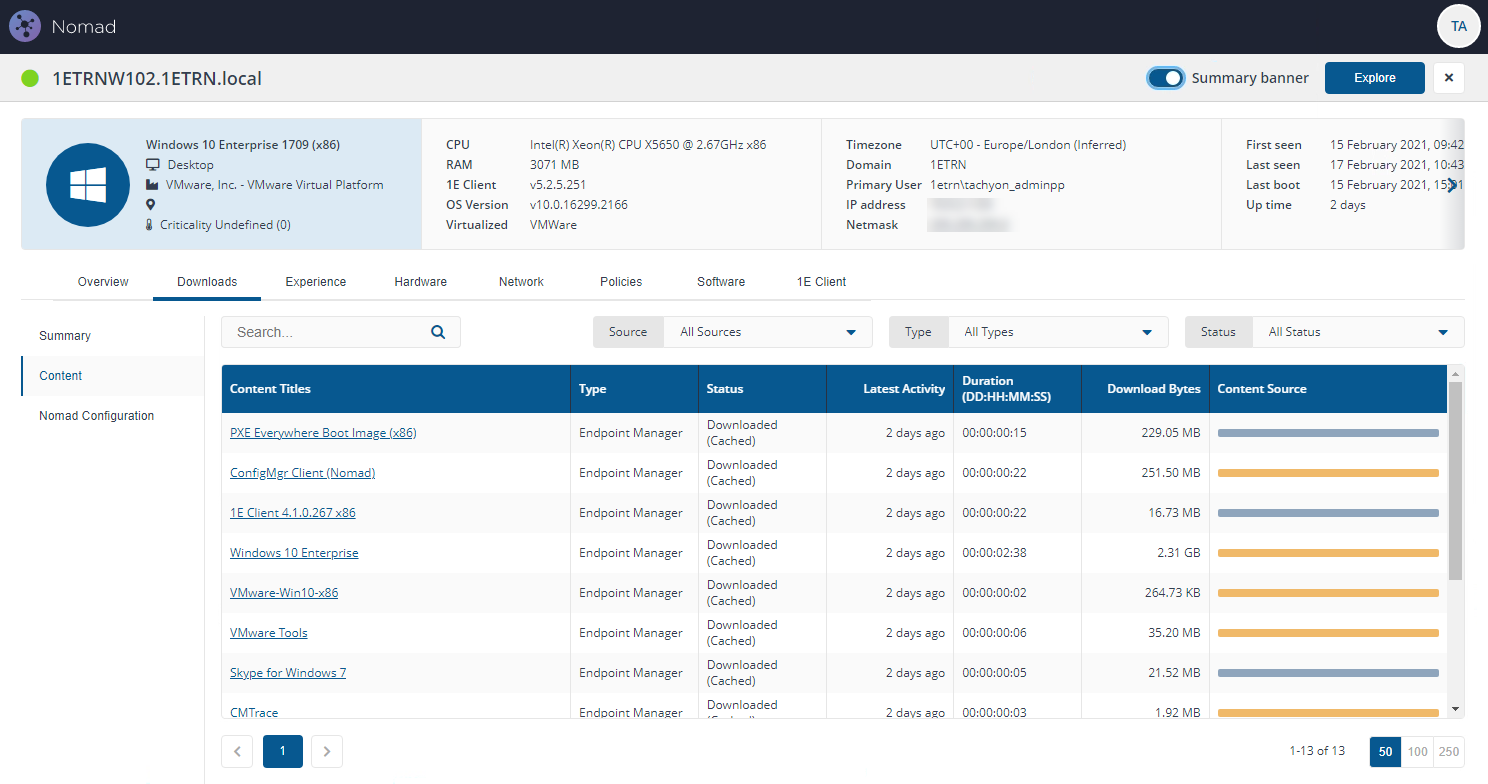
Nomad Configuration
Shows the 1E Nomad Branch Settings for the selected device. You can use this to check a device's Nomad registry entries if the device is not behaving as expected.
The registry details presented are gathered by the 1E-Nomad-NomadBranchSettings instruction of the 1E Nomad product pack.
Classic product pack used to create the 1E Nomad instruction set in Tachyon, required by the following Nomad features:
Downloads tab on Device views - instructions used to populate details about Content download and other Nomad features
Nomad Download Pause - instructions used by the CM Admin Console extensions
Instructions to help with the following Nomad features: Nomad cache, CacheCleaner, Single Site Download, Nomad jobs, NomadBranch service.
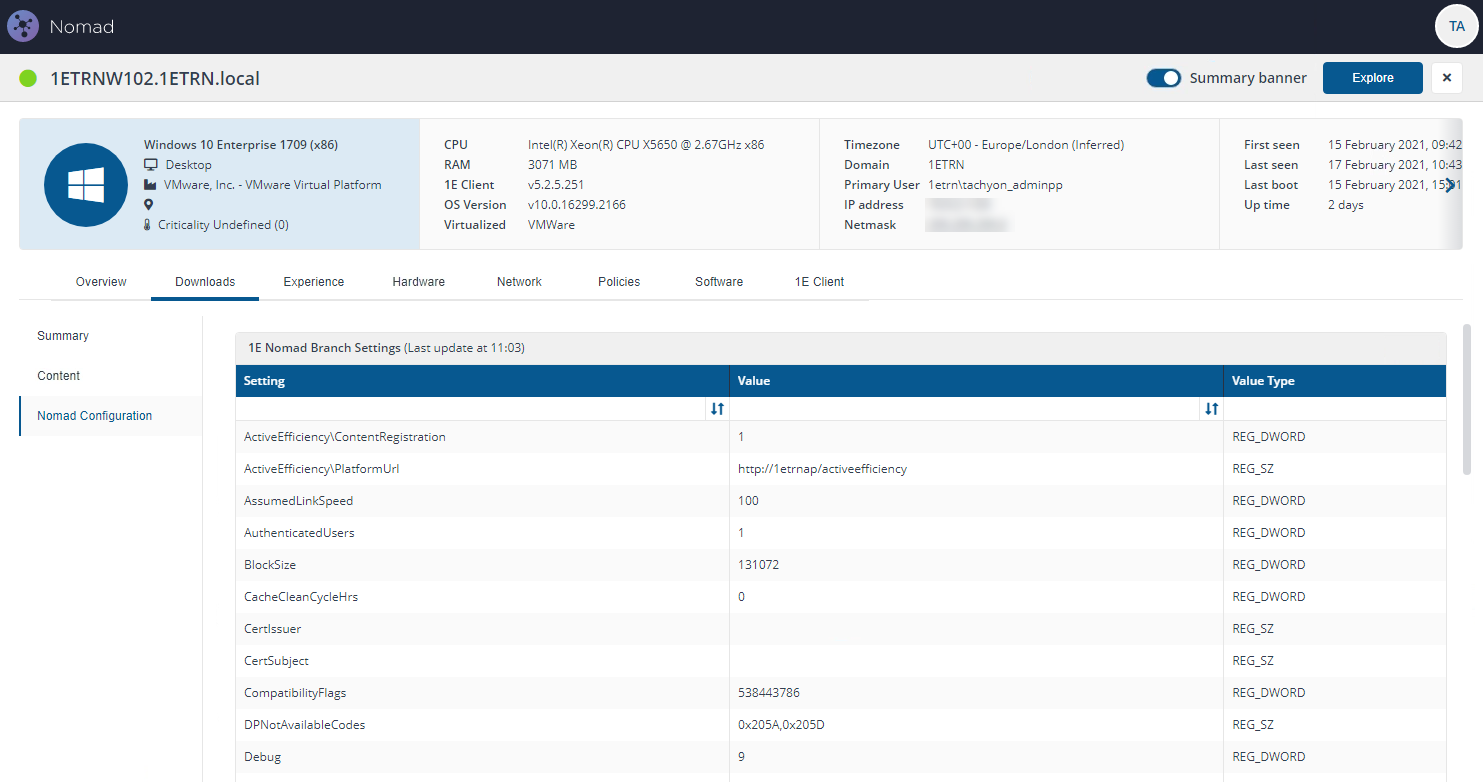
The 1E Nomad Branch Settings panel is expandable. Moving your mouse over the panel reveals an Expand button on the top left of the panel and a refresh button. Clicking the refresh button, re-runs the 1E-Nomad-NomadBranchSettings instruction.

A full list of Nomad registry values by feature are available on the Nomad registry values page. Registry values for NomadBranch are located in: HKLM\Software\1E\NomadBranch

Summary banner
The Summary banner displays a quick summary of the information provided in the various tabs displayed in the Device View. It can be viewed by toggling the Summary banner switch to on.
The following picture shows the Summary banner displayed for a particular device.
The following table describes the information provided in the Summary banner.
Panel | Description | Data source | ||||||||||||||||||||||||||||||||
|---|---|---|---|---|---|---|---|---|---|---|---|---|---|---|---|---|---|---|---|---|---|---|---|---|---|---|---|---|---|---|---|---|---|---|
Shows details equivalent to the following tiles:
| Data from Tachyon Master (the latest online status message) | |||||||||||||||||||||||||||||||||
Shows details equivalent to the following tiles:
| ||||||||||||||||||||||||||||||||||
Shows details equivalent to the following tiles:
| ||||||||||||||||||||||||||||||||||
Shows details equivalent to the following tiles:
| ||||||||||||||||||||||||||||||||||
Shows details equivalent to the following tiles:
|
Additional Device View tabs
In addition to the Downloads tab, there are a series of tabs, each corresponding to an app, feature or data set implemented in Tachyon.
The Overview and 1E Client tabs are always present in the Device View. Other tabs are visible if an app has been installed and is licensed.
Each tab has one or more panels with tiles populated with data from various sources, some by instructions that are run instantly, with results cached for 3 minutes. An appropriate error message is displayed instead of a tile in the following circumstances:
If the device is offline, as indicated by the color of the icon in the top left
The user does not have at least Viewer permission to view use the license the tab or panel
The user does not have questioner permission to run the instruction
An instruction has not been uploaded.
The The Device View tabs and panels page lists the names of tabs and their panels, and a description of each tile indicating how the tile is populated.
The Device view Downloads tab
The Device view is a common view used throughout Tachyon to present details of a device from multiple Tachyon Platform applications.
The default view in the Nomad devices view is Downloads. The remaining tabs display information corresponding to an app, feature or data set implemented in Tachyon, other tabs are visible if an app has been installed and licensed, and the user has permissions to use the app, refer to Additional Device View Tabs for detail. Clicking on one of the links in the FQDN column of the Devices page displays the Device view for the selected device. The aim of the Device view is to provide a combined overview of all the information known about a device, along with the ability to retrieve information about the device in real-time. When displaying the Device view from a Nomad page, the view defaults to the Downloads tab. The Downloads tab contains information derived from and useful for using Nomad.
In addition, the Summary banner displays a quick summary of the information provided in the various tabs displayed in the Device View. It can be viewed by toggling the Summary banner switch to on, refer to Summary banner for details.
Note
The Time period filter does not apply to detail pages. As a result, if you have set theTime periodfilter on theDevices page to, for example,Last 7 days, you may see different results on the detail page for a device.
Note
The details shown on the Downloads and other tabs rely on access to the associated app, but also Instruction Sets used by the Tachyon Platform. >To view details in the Downloads tab for the Nomad app you'll need to load the 1E Nomad product pack. For more details, refer to Installing the Nomad app - 1E Nomad product pack.
Downloads tab
TheDownloadstab has three items:
The Downloads tab presents download activity and status for the device. Whenever you click on an FQDN on any of the Nomad dashboard pages, the Device details page will be displayed with the Downloads tab selected.
Summary
Summary has four panels:
Status bar
Bandwidth Usage Per Day by Content Source (UTC)
P2P Efficiency by Content Source
Content Titles Count by Content Type.

Status bar
The status bar along the top shows high-level download statistics for this device:
Column | Description |
|---|---|
Downloaded | Number of completed downloads on this device. |
Downloading | Number of downloads that are actively in progress on this device. |
Failed | Number of downloads on devices that are currently in the site, whose latest status is failed. |
Bandwidth Protection | Bandwidth Protection allows Nomad to adjust the speed of ongoing downloads to save bandwidth for other business use. Bandwidth Protection ensures Nomad doesn't consume excess bandwidth and hinder other business activity. |
Clicking on any of these icons will navigate to theContentview of theDevice detailtab, filtered according to the clicked icon.

Bandwidth Usage Per Day by Content Source (UTC)
The Bandwidth Usage Per Day by Content Source (UTC) tile represents daily download activity on this device for the last 30 days. A column is displayed for each day when there was download activity. Each column indicates the volume of content that was downloaded over the WAN (in orange) or from peers (in grey).
Hovering over a segment of the column displays the volume of content downloaded on that day, demonstrating the value that Nomad and Delivery Optimization are providing through reduced WAN traffic. If the majority of content is being downloaded over the WAN, it could indicate that peers are simply not available (e.g. this device is being used from home) or it could be an indication that Nomad or Delivery Optimization are not correctly configured to optimize content from peers.

P2P Efficiency by Content Source
The P2P Efficiency by Content Source tile represents the overall peer-to-peer efficiency on this device. The data is grouped by source (Peers and WAN) and displayed as a donut chart showing the volume of content downloaded from peers (in grey) and from the source over the WAN (in orange).
The chart gives an indication of the overall value of Nomad and Delivery Optimization on this device. Ideally, more content will be downloaded from peers than from the source over the WAN, thereby saving network bandwidth. Where this is not the case, it could be due to remote working (where there are no peers available), or it could be due to configuration settings on the client that are not optimized for peer-to-peer caching and availability.
Clicking on a segment in this chart will navigate to the Content view for this device, filtered to show content that was downloaded from the selected source (Peer or WAN).

Content Titles Count by Content Type
The Content Titles Count by Content Type chart gives an indication of the number of Endpoint Manager applications and Software Update this device has downloaded.
Clicking on a segment in this chart will navigate to the Content view for this device, filtered by the selected Content Type.

Content
The Content panel shows the status of content downloaded on the device:
Column | Description |
|---|---|
Content Titles | Content title, for:
|
Type | Currently, either Endpoint Manager or Software Update. |
Status | Current status of the content on this device. This can include the following statuses.
|
Latest Activity | Date and time of the latest event for the content title on this device. |
Duration | The time taken to download the content. |
Download Bytes | Amount of bytes of the content actually downloaded by the device. In some cases, especially with Software Updates, only deltas or byte ranges will be downloaded rather than the entire source content. |
Content Source | A bar indicating the proportion of the content that was downloaded over the WAN or from peers. |
Note
The Time period filter does not apply to detail pages.
As a result, if you have set the Time period filter on the Devices page to, for example, Last 7 days, you may see different results on the detail page for a device.

Nomad Configuration
Shows the 1E Nomad Branch Settings for the selected device. You can use this to check a device's Nomad registry entries if the device is not behaving as expected.
The registry details presented are gathered by the 1E-Nomad-NomadBranchSettings instruction of the 1E Nomad product pack.
Classic product pack used to create the 1E Nomad instruction set in Tachyon, required by the following Nomad features:
Downloads tab on Device views - instructions used to populate details about Content download and other Nomad features
Nomad Download Pause - instructions used by the CM Admin Console extensions
Instructions to help with the following Nomad features: Nomad cache, CacheCleaner, Single Site Download, Nomad jobs, NomadBranch service.

The 1E Nomad Branch Settings panel is expandable. Moving your mouse over the panel reveals an Expand button on the top left of the panel and a refresh button. Clicking the refresh button, re-runs the 1E-Nomad-NomadBranchSettings instruction.

A full list of Nomad registry values by feature are available on the Nomad registry values page. Registry values for NomadBranch are located in: HKLM\Software\1E\NomadBranch

Summary banner
The Summary banner displays a quick summary of the information provided in the various tabs displayed in the Device View. It can be viewed by toggling the Summary banner switch to on.
The following picture shows the Summary banner displayed for a particular device.
The following table describes the information provided in the Summary banner.
Panel | Description | Data source | ||||||||||||||||||||||||||||||||
|---|---|---|---|---|---|---|---|---|---|---|---|---|---|---|---|---|---|---|---|---|---|---|---|---|---|---|---|---|---|---|---|---|---|---|
Shows details equivalent to the following tiles:
| Data from Tachyon Master (the latest online status message) | |||||||||||||||||||||||||||||||||
Shows details equivalent to the following tiles:
| ||||||||||||||||||||||||||||||||||
Shows details equivalent to the following tiles:
| ||||||||||||||||||||||||||||||||||
Shows details equivalent to the following tiles:
| ||||||||||||||||||||||||||||||||||
Shows details equivalent to the following tiles:
|
Additional Device View tabs
In addition to the Downloads tab, there are a series of tabs, each corresponding to an app, feature or data set implemented in Tachyon.
The Overview and 1E Client tabs are always present in the Device View. Other tabs are visible if an app has been installed and is licensed.
Each tab has one or more panels with tiles populated with data from various sources, some by instructions that are run instantly, with results cached for 3 minutes. An appropriate error message is displayed instead of a tile in the following circumstances:
If the device is offline, as indicated by the color of the icon in the top left
The user does not have at least Viewer permission to view use the license the tab or panel
The user does not have questioner permission to run the instruction
An instruction has not been uploaded.
The The Device View tabs and panels page lists the names of tabs and their panels, and a description of each tile indicating how the tile is populated.
